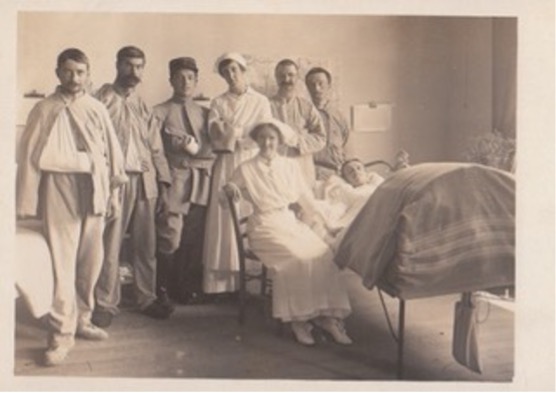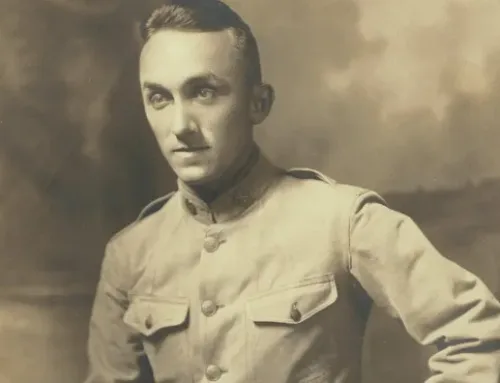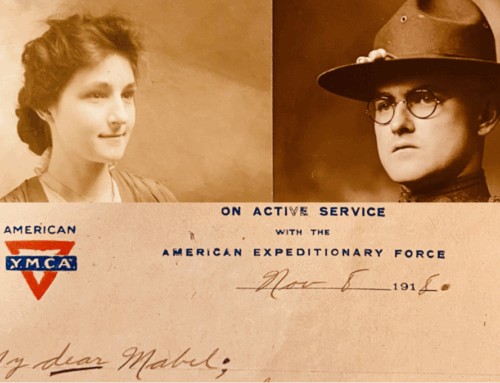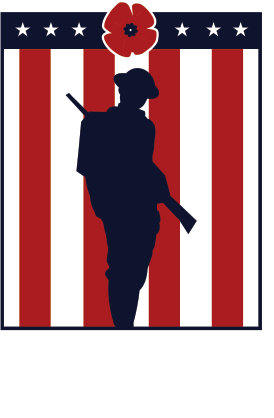Women’s History Month: Honoring World War I Nurses and Norfolk’s Own Kate Talcott Cooke
Published: 18 March 2025
By Annette Finley-Croswhite
via the Old Dominion University website

kate-cooke-lechaux-article
Kate Talcott Cooke Lechaux (standing in middle) in the American “Ambulance” in Paris. Undated picture taken during World War I. Lechaux Family Archives.
World War I (1914-1918) played a critical role in advancing the nursing profession in the United States and the role of female nurses in general. During World War I women joined both the U.S. Army and Navy as nurses although they were never recognized as either enlisted or commissioned personnel. Even so, the nursing ranks grew during the war rising from 573 nurses in the U.S. Army at the beginning of the war to over 21,480 Army nurses by the war’s end. The U.S. Navy also employed around 1500 nurses by 1918. Most Army nurses were stationed overseas; many were recruited from the American Red Cross.
World War I was one of the deadliest wars in human history with an estimated 40 million military and civilian casualties. Because of the mechanization of warfare, the nature of battlefield wounds changed as artillery shells and machine guns ripped apart combatants’ bodies causing dismemberment and death. Poisonous gases including phosgene, chlorine, mustard, and tear gas were introduced, and victims were often left with life-long disabilities. “Shell shock” was also identified seriously for the first time as a result of psychological battle damage. Rapid treatment became essential to saving soldiers’ lives, leading to the development of evacuation and triage stations near the battlefront. In these instances, nurses proved crucial to saving men’s lives as they helped to stabilize the wounded on the front lines. Many nurses learned to drive ambulances, advance orthopedic rehabilitative medicine, provide mental health care, and some even became proficient with administering anesthesia, a life-saving intervention that allowed doctors more time to treat serious war wounds while patients were unconscious.
Not all women who served in World War I were trained nurses. Many flocked to the nursing profession and received on-the-job training as members of volunteer nursing auxiliary services. In these situations, they usually worked to support trained nurses often in very dangerous battlefront situations. In the United States, many people were frustrated by America’s isolationist stance and went to Europe to serve as early as 1914 even though the country did not formally enter the war until 1917. Many of these individuals were women who traveled to Europe to offer nursing services.
This was the situation for Katherine “Kate” Talcott Cooke, a wealthy and well-educated woman born and raised in a mansion on Bute Street in Norfolk, Virginia who felt compelled to sail to France to help the war effort. Bored with her life in upper-class society, she perceived the regular routines of women in her situation as stultifying. She stated, “I abhor the women in my circle of family and friends who talk of nothing but camellias and babies.” Kate was vehemently pro-American intervention and thought President Woodrow Wilson was playing politics by not intervening before the 1916 election.
Kate arrived in Paris in 1915 and quickly joined the auxiliary nurses at the American Hospital in Paris. That establishment predated the war but in 1914 the governors of the hospital decided to dedicate their time and resources to helping the French face the ramifications of war. The French government loaned the Americans an unfinished high school that American architects quickly turned into a 600-bed auxiliary hospital. The American Chamber of Commerce in Paris sent out calls to the nation and soon doctors and nurses from all over the United States arrived in the French capital. Their arrival reflected a massive American humanitarian effort to support the French during World War I, and these volunteers also helped gradually sway the American public away from neutrality.
Kate Cooke joined the humanitarian cause. Her family’s wealth was essential because auxiliary nurses were not initially paid and had to rely on other means of support. Even when small allowances were allocated later in the war to volunteer auxiliary nurses, it was never enough to live on. Kate enjoyed a bank account tied to her family’s wealth which allowed her to stay in Paris throughout the war.
Kate Cooke’s letters to her mother written from Paris during World War I are housed in the Slover Library’s Sargeant Memorial Collection in Norfolk as part of the records of the Virginia War History Commission and provide the source material for this article. Like many aristocratic girls of her generation, she became interested in both World War I and the women’s suffrage movement. Kate Cooke went to France as a twenty-six-year-old single woman to join the ex-Pat community and experience Parisian life. At the American Hospital in Paris, she was assigned to the “American Ambulance,” the section that eventually had 35 Model-T ambulances that medics and nurses, including Kate, drove to the frontlines to retrieve wounded soldiers and return them to Paris to nurse them back to health. Kate was a nurse’s aide, a position in which she learned to administer anesthesia. During her years of work in Paris, she showed real agency as an independent woman, willing to risk her own life in the service of others.
→ Read the entire article on the Old Dominion University website.
External Web Site Notice: This page contains information directly presented from an external source. The terms and conditions of this page may not be the same as those of this website. Click here to read the full disclaimer notice for external web sites. Thank you.



